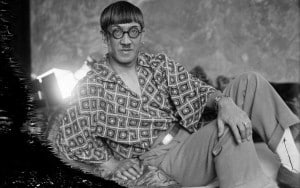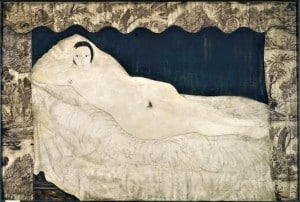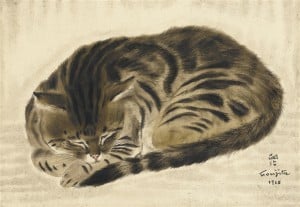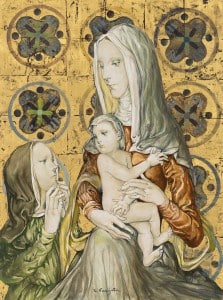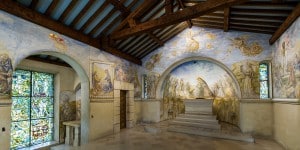Foujita: When Japanese Heritage Meets Western Modernism
Chatham Maison is dedicating his annual exhibition to Japanese-French artist Foujita, a distinctive figure of the 20th century Parisian avant-garde, fusing Western and Eastern artistic traditions.
Held until 7 September 2024, Foujita, A Line That Never Ends is showcasing the artist’s artworks for the first time in Hong Kong. It also narrates the story of Foujita’s extraordinary life through texts, photographs, videos, interviews and displays, following different artistic periods and thematics: 1914 – 1920 Early Series; Cats Series; Nude Woman Series; Maidens Series, and Holy Mother Series, including works by Foujita from 1914 to 1961.
Léonard Tsuguharu Foujita (1886 – 1968) was born Fujita Tsuguharu into an aristocratic family in Tokyo, Japan. He developed his interest in painting in primary school and soon decided to become a painter. When he was a teenager, one of his watercolours was even exhibited at the Exposition Universelle de Paris to represent artworks by Japanese middle schoolers.
His parents embraced Western culture and encouraged him to learn French from a young age. After studying Western art at the Tokyo University of Fine Arts, Foujita made a pivotal trip to Paris in 1913 and didn’t return home for the next twenty years, telling his father: “Consider me dead until I become famous”.
Changing his name into a more Frenchified “Foujita”, he embraced the Parisian life and settled into the bohemian neighbourhood of Montparnasse, getting noticed with his signature look: bowl haircut, round glasses and gold hoop earrings. He was even wearing a lampshade on his head to got to the opera, pretending it was a conventional accessory in Japan!
Friend with artists like Modigliani, Soutine, Picasso and Matisse, Foujita developed a reputation of a colourful character, an extrovert nicknamed “Fou Fou” by his friends (“crazy”). But don’t be mistaken by his bohemian appearance: the artist never drank any alcohol, kept meticulously clean – unlike Soutine who never used any toothbrush! – and worked persistently.
In 1917, Foujita met Fernande, model for Modigliani, and married her 13 days later. Fernande was instrumental in his first success, helping him to organise his first solo exhibition at Gallery Chéron in Paris. The exhibition was an unequivocal triumph, with all of his 110 artworks being sold on the first day. At the the opening, Picasso bought as many watercolours as he could carry!
By the early 1920s, Foujita was known for his signature style, marrying traditional Japanese techniques with European Modernism in his self portraits, interior scenes and nudes. His canvases combined oil paint with touches of “sumi”, oriental ink, and his choice of brush was the ultra-thin menso, renowned in Japan for its precision.
Among his most celebrated paintings were his nude series. One of his first, Nu couché à la toile de Jouy, was of model and cabaret performer Kiki de Montparnasse and caused a sensation at the Salon d’Automne in 1922.
Foujita married five times and each of his wives served as a model for his nudes. Unlike the odalisques painted by Ingres, his nudes were modelled with a lack of shading and colour, thus creating an atmosphere of simplicity and serenity.
Foujita reinterpreted a key motif of the Western nude art through a Japanese lens, considering skin as “the most beautiful material that can be”. This was achieved thanks to his mesmerising milky-white glaze, which recipe he kept secret for a longtime. He eventually revealed that it was made with flaxseed oil, crushed chalk and magnesium silicate, creating a combination giving his paintings a pearly luminescence that Westerners had never seen before.
The artist was also famous for his cats series, depicting the animals either alone, together with other cats, with himself in self-portraits, or with his female models in nudes.
During his twenty years in Paris, Foujita made a fortune from his art, but he was more of a spender than a saver. In the 1930s, unable to pay his debt to the French taxes, he left Paris and his third wife Lucie Badoul “Youki”, and fled to Latin America with his new lover, Madeleine.
In the late 30s, he moved back to Japan and became official painter for the imperial army during the Second World War. His paintings of large battle scenes were acclaimed during the war, but later criticised as propaganda.
In 1950, Foujita returned for good to France with Kimiyo Horiuchi, who would become his fifth wife in 1954. In 1955, he became a French citizen and, in 1957, he was the first Asian artist to be made Officer of the Legion of Honour by the French government.
In 1959, Foujita converted to Catholicism and was baptised at Reims Cathedral, taking the Christian name of Léonard. He then increasingly began to adopt religious subject matter, painting a large number of Madonna and Child covered with gold leaf and filled with a sacred atmosphere.
Foujita dedicated his final years to conceive his own chapel, the Chapel of Our Lady Queen of Peace in Reims, commonly known as Foujita Chapel.
From 1963 to 1966, he designed almost every aspect of the chapel and decorated the interior with frescoes of biblical scenes.
Foujita died on 29 January 1968, only a few months after the opening of the chapel.
More details of the retrospective exhibition at Maison Chatham can be found here: Foujita, A Line that Never Ends
